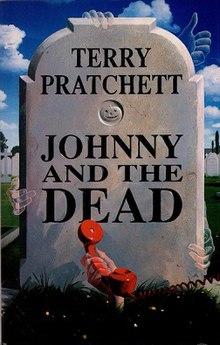Johnny and the Dead

1994 Paperback (Corgi)
|
|
| Author | Terry Pratchett |
|---|---|
| Cover artist | John Avon |
| Country | United Kingdom |
| Language | English |
| Series | Johnny Maxwell Trilogy |
| Genre | Children's literature, Fantasy |
| Publisher | Doubleday (London) |
|
Publication date
|
1993 |
| Media type | book |
| ISBN | |
| OCLC | 28889741 |
| Preceded by | Only You Can Save Mankind (1992) |
| Followed by | Johnny and the Bomb (1996) |
Johnny and the Dead (1993) is the second novel by Terry Pratchett to feature the character Johnny Maxwell. The other novels in the Johnny Maxwell Trilogy are Only You Can Save Mankind (1992) and Johnny and the Bomb (1996). In this story, Johnny sees and speaks with the spirits (they object to the term "ghost") of those interred in his local cemetery and tries to help them when their home is threatened.
Johnny and the Dead is a feature of some schools' English curriculum.
The story starts with Johnny Maxwell, a twelve-year-old boy, taking a shortcut through the local Blackbury cemetery to reach his home. In the cemetery, Johnny meets the spirit of Alderman Thomas Bowler and realizes that he can interact with the spirits of the dead. Later, Johnny meets all the deceased occupants of the cemetery and discusses with them the council's sale of Blackbury's neglected cemetery to a faceless conglomerate, who plan to build offices on it. Various dead citizens, led by a former town councillor, ask Johnny to help stop it.
While Johnny (helped by his semi-believing friends) tries to find evidence of famous interees and speaks out at community meetings, the dead begin to take an interest in modern-day life and realise they are not, as they once believed, trapped in the cemetery.
Finally the council is forced to back down, but the dead are no longer interested; they have decided that instead of waiting for the Day of Judgement, they will make the decision themselves. Most of them depart the cemetery to continue their journey into the afterlife but, thanks to the campaigning of the Blackbury Volunteers, the town's living residents have rediscovered the cemetery as a link to their past. As one of the dead puts it before leaving: "The living must remember, and the dead must forget."
The book is loosely based on real events in Westminster in the 1980s, when the council sold three cemeteries as building land for 15p (Pratchett was working as a journalist at this time).
Part of the story deals with the last surviving member of the Blackbury pals, a Pals battalion with obvious parallel to the Accrington Pals. This gentleman is called Tommy Atkins, the name given to the generic British soldier of the day.
...
Wikipedia
